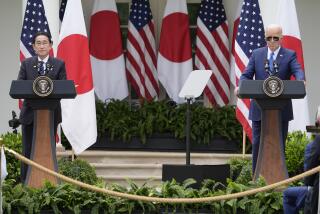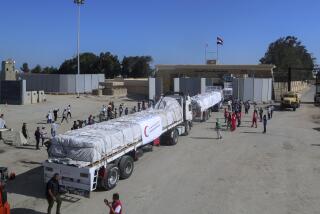Together, No. 2 and No. 1 Can Help a Planet Blossom : Foreign Aid: America’s program has lost its way. Linking development resources with Japan’s is the way to go.
For the first time since World War II, the United States is not the dominant player in the foreign-aid field. According to statistics released in late June by the Organization for Economic Cooperation and Development, Japan provided $9 billion in development assistance in 1989; the U.S. contribution dropped to $7.7 billion.
Some observers will greet this as long overdue news. After all, the United States has severe budgetary problems, and Japan should assume a larger share of the aid burden. Others may see it as evidence that the Japanese are now using the need to provide aid as a justification for maintaining a trade surplus. Whatever the case, it shouldn’t stand in the way of the countries discussing how they can work together to meet new development challenges. The United States is justly proud of its leadership in establishing a system of development cooperation that in only four decades has catalyzed remarkable progress in the developing world. Despite the continuation of unacceptable levels of poverty, income has grown in many parts of the developing world. Life expectancy and literacy in some countries are now approaching levels achieved by the industrial countries only in this century.
But America’s development program has lost its way. In the early postwar years, aid levels reached well over 2% of gross national product. In 1989, when its economy was considerably richer, the United States spent only 15/100s of 1% GNP on development assistance. That is now the lowest percentage of any industrial country member of the OECD.
Even more important, the U.S. aid program is heavily weighted to short-term security and political concerns in the better-off developing countries. According to data from the Overseas Development Council, security aid claims nearly 60% of the Bush Administration’s current aid request. It would allocate $258.88 per person to high-income countries receiving U.S. aid, and only 84 cents per person in the low-income countries.
Over the past decade, our deteriorating aid performance has been justified on the grounds that even if we spent a lower percentage of our GNP on aid, we were the world’s largest donor and that we were bearing a disproportionate share of the cost of global defense.
Japan, on the other hand, has been taking on increasing responsibility for promoting development. Japanese aid increased by 87% between 1980 and 1987, and further increases are planned. Japan is now the largest bilateral aid donor in 25 countries and provides twice as high a percentage of its GNP for aid as the United States. Japan also has provided financing for debt relief through the World Bank and the International Monetary Fund and to meet emerging needs in Eastern Europe and reportedly in Panama and Nicaragua. The commercial emphasis that marked Japan’s aid program in earlier years has diminished greatly. Now the program is increasingly marked by a concern with development in the recipient countries.
How will the United States respond to becoming No. 2 in the development field? A growing number of policy-makers agree that the current U.S. aid program has become an anachronism. Not only is it dominated by Cold War security concerns, it is also disproportionately concentrated in a few areas of traditional U.S. interest: Israel and Egypt, Southern Europe, Central America, Pakistan and the Philippines. The growing tension between emerging new needs to promote democracy and economic growth in Latin America and Eastern Europe, and to meet the critical challenges of African development, has led to a growing clamor, particularly in Congress, for an overhaul in U.S. aid strategy.
Policy-makers in the United States and Japan face an emerging global agenda of interrelated issues. Cooperation between the two countries should focus on policies designed to resume global economic growth, to sustain the environment upon which both industrial and developing countries depend, to eliminate the conditions that consign 1 billion people to live in absolute poverty in a world of plenty and, finally, to promote and sustain the remarkable flowering of political openness the world has witnessed in recent years.
The United States and Japan have abundant development resources--in policy-making and other skills, in innovation and human talent, as well as money--unique to each country. The need for their cooperation is too great to waste energy on stale debate about who is No. 1.
More to Read
Sign up for Essential California
The most important California stories and recommendations in your inbox every morning.
You may occasionally receive promotional content from the Los Angeles Times.










